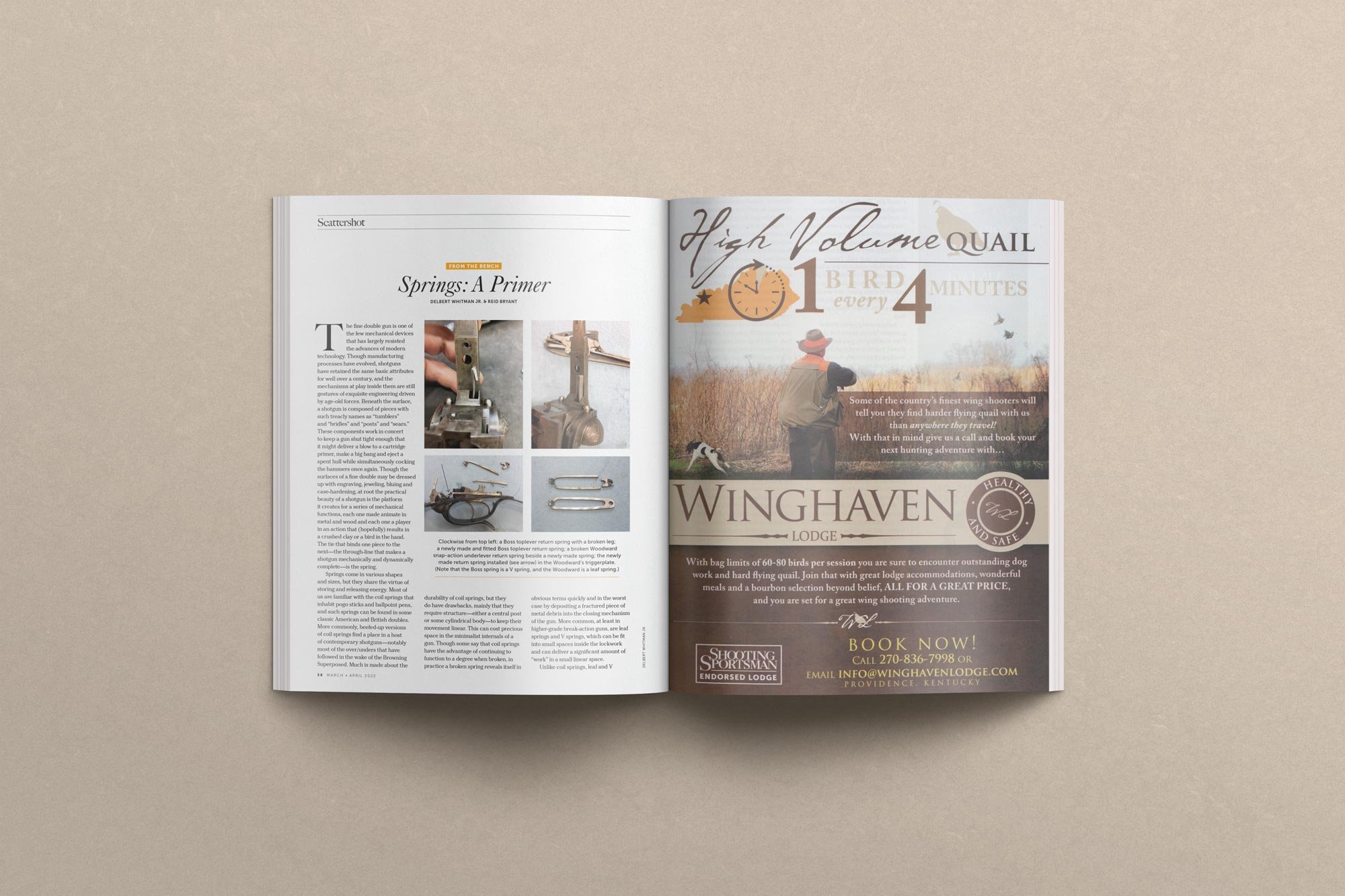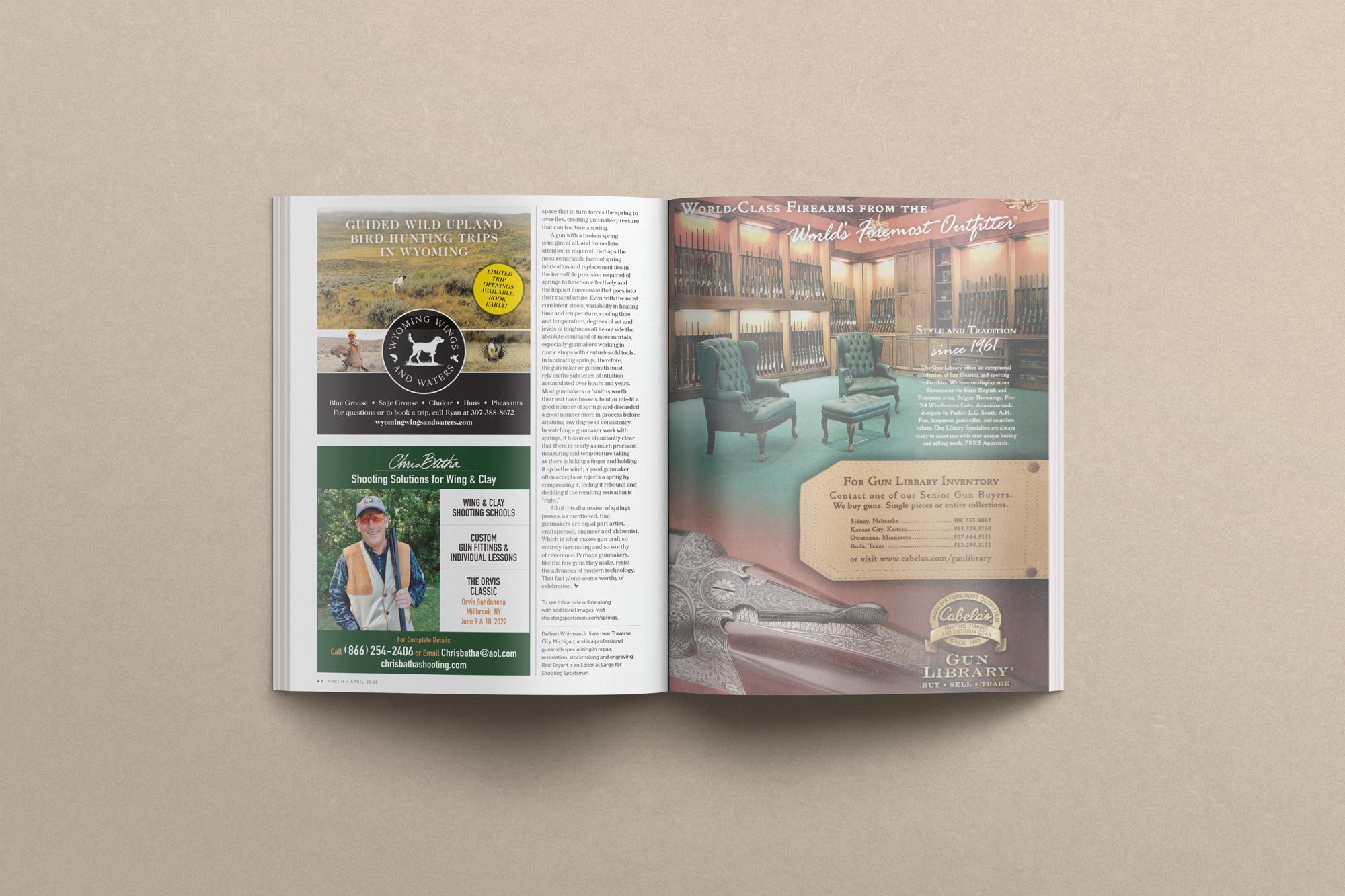Springs: A Primer
The fine double gun is one of the few mechanical devices that has largely resisted the advances of the modern technology. Though manufacturing processes have evolved, shotguns have retained the same basic attributes for well over a century, and the mechanisms at play inside them are still gestures of exquisite engineering driven by age-old forces. Beneath the surface, a shotgun is composed of pieces with such treacly names as tumblers and bridles and posts and sears… these components work in concert to keep a gun shut tight enough that it might deliver a blow to a cartridge primer, make a big bang, and eject a spent hull while simultaneously cocking the hammers once again. Though the surfaces of a fine double may be dressed up with engraving, jeweling, bluing, and casehardening, at root the practical beauty of a shotgun is the platform it creates for a series of mechanical functions, each one made animate in metal and wood, and each one a player in an action that results in a crushed clay or a bird in the hand. The tie that binds one piece to the next, the through-line that makes a shotgun mechanically and dynamically complete, is the spring.
Springs come in various shapes and sizes, but they share the virtue of storing and releasing energy. Most of us are familiar with the coil springs that inhabit our pogo sticks and ballpoint pens, and such springs can be found in some classic American and British doubles. More commonly, beefed-up versions of coil springs find a place in a host of contemporary shotguns, notably most over-unders that followed in the wake of the Browning Superposed. Much is made about the durability of the coil spring, but they do have drawbacks, mainly that they require structure, either a central post or some cylindrical body, to keep their movement linear. This can cost precious space in the minimalist internals of a gun. Though some say that coil springs have the advantage of continuing to function to a degree when broken, in practice a broken spring reveals itself in obvious terms quickly, in the worst case by depositing a fractured piece of metal debris into the closing mechanism of the gun. More common, at least in higher-grade, break-action guns, are leaf springs and V-springs, which can be fit into small spaces inside the lockwork, and which can deliver a significant amount of “work” in a small linear space.
Unlike coil springs, leaf and V-springs are pieces of metal that become compressed into or out of a bend rather than compressed into a linear coil before being allowed to rebound. Virtually every action that a shotgun performs begins either with the compression of a V or leaf spring, or the release of said compression, and a resulting transfer of energy. Leaf and V-springs are employed widely in best guns, sidelock or triggerplate guns especially, as mainsprings, toplever springs, and ejector springs. The use of the V or leaf type really hinges upon the space available: a leaf spring does not have the defining radical bend of a V type, and therefore can deliver a significant amount of energy without involving the descriptive kink or V. This in turn makes the leaf spring stronger, nominally anyway, but requires sufficient space in the guns internals to do the work requires. Where space is an issue, such as in the Holland sidelock mechanism, the leaf is, for conversation’s sake, folded in half. The resulting V-spring takes up far less linear space.
No two springs are exactly alike, and few are readily available for plug-and-play application in the repair or manufacture of a fine double. For this reason, a gunmaker must possess a comprehensive understanding of springs and their manufacture, largely because springs are made to order, and broken springs are replaced and/or replicated by a process that involves extensive handwork. Those who build or fix best guns or classic guns will spend a significant portion of a career fabricating springs out of raw metal, noting that the process requires precise cutting, shaping, and fitting of a static part, but also a solid understanding of the degree to which that part will compress and rebound under a pre-determined degree of pressure. In essence, the gunmaker must understand principles of construction, metallurgy, and physics, and must understand how those principles can be applied to effectively store and deliver energy. Add to these considerations the fact that a spring must remain tough and durable over a lifetime of heavy use (perhaps abuse), and that a spring under compression will invariably take a degree of a bend or set, and you have, in spring fabrication, a better understanding of the complex alchemy that is spring making.
In discussing springs and how they are constructed, let’s start with some universal truths. A leaf or V-spring is made from a block or bar of stock spring steel, and steel is a compound of iron and carbon. Most spring steel employed by DC Whitman Custom Gunsmithing is nominally 1095, which refers to a steel alloy composed of.95% (approximately 1%) carbon (though an alloy of lower carbon content has been traditionally used). This alloy has a higher concentration of carbon than standard sheet steel, which allows it to take the heat treating required to make a traditional spring sufficiently hard while remaining elastic. In layman’s terms, one might imagine the iron molecules in spring steel as ball bearings, and the carbon as a medium like clay. The ball bearings are scattered throughout the lump of clay, and with heating and cooling the clay expands and contracts, becoming either stiff or slack. This expansion and contraction allows the ball bearings that are suspended in the clay to move apart with heat, and to pull tighter together once cooled.
In most cases, when a gunmaker sets out to make a spring, he or she first measures, cuts, tapers, bends, and files/polishes the steel to its approximate finished dimensions (note that this process alone requires a gunmaker to create a complex shape in metal, doing so with enough precision that the spring fits into the tight confines of a lockwork or inletted stock). Once that process is complete, the spring needs to be hardened and tempered.
Inherently, springs need to be hard so that they are rigid enough to retain their shape, rather than taking a bend or a set. Heat treating is the process by which ferric metal is hardened and made resistant to bending. In heat treating, 1095 spring steel is heated up to its most excited state (specifically to a temperature around 1650 degrees), at which point the (clay) or carbon relaxes, which allows the iron molecules or (ball bearings) to spread out. The steel is then cooled by quenching in oil, thereby contracting the bond between iron and carbon (contracting the clay and pulling the ball bearings back together). This contraction makes the steel hard, and the degree of hardness, measured as a Rockwell figure, correlates directly to the intended function of the spring, and the degree to which it may be compressed. Typical spring steel can only be hardened to a rating of 60 Rockwell, which is too hard to file, and very brittle. A 50 Rockwell rating or so is far more common, and more receptive to the final shaping and polishing that is often required after heat treating and tempering is done.
Noting that the heat-treated spring is now quite hard but brittle, it’s composition must be made more elastic. The process of making a spring “springy” rather than brittle is known as tempering. Tempering requires the gunmaker to heat the spring again to a point at which those molecular bonds relax enough that they won’t fracture under pressure. Some hardness is sacrificed, but elasticity is gained, and the resulting “springiness” is what gunmakers call “toughness”. When a spring is not sufficiently tempered, it will remain brittle and will likely break. When a spring is over-tempered or under-hardened it will be too soft and will take a set or an unwanted bend rather than storing energy. A properly tuned spring will, under first compression, take a tiny set but will spring back readily, and will have sufficient toughness to do so reliably for a lifetime.
A shotgun’s action houses a series of springs that act upon different parts to make mechanical functions happen in series. Shotgun shooters feel these springs at work whenever a gun is opened or closed, or whenever a trigger is pulled. Note the pressure the thumb exerts on a toplever when a gun is opened, and the snappy return that the toplever takes when the gun snicks closed? Note the radial pressure exerted on barrel when the gun is opened and re-cocked after a shot, simultaneously allowing ejectors to deploy and kick out spent hulls with vehemence? All of these actions describe either the compression of springs inside the gun, or the release of energy stored in a compressed spring. Smaller scale spring action takes place throughout the process of trigger articulation and ejection as well, though when properly tempered the small, delicate springs nestled in such a vehicle as a Holland-style lockplate are remarkably durable, and rarely break. Toplever springs, hammer springs, mainsprings… those larger springs are generally the ones that receive maximum pressures and therefore see breakage, and therefore require replacement by gunsmiths and gunmakers.
So why do springs fail? Springs can and do fail from over-use. In older guns failure can often be attributed to inconsistencies in the steel itself. Imagine, continued pressure applied to a toplever spring by manual compression will look for a weak point through which to release. Inconsistencies in hundred-year-old steel, even microscopic flaws, are the culprits of many broken toplever springs. Moreover, unrelated damage and/or wear can result in broken bits of metal or shards of wood rattling around in a shotgun’s guts, and this debris poses the risk of interrupting the intended travel of the spring between compression and release. This proverbial “wrench in the works” often reduces tolerances or occupies space that in turn forces the spring to over-flex, creating untenable pressure that can fracture a spring.
A gun with a broken spring is no gun at all, and immediate attention is required. Perhaps the most remarkable facet of spring fabrication and replacement lies in the incredible precision required of springs to function effectively, and the implicit imprecision that goes into their manufacture. Even with the most consistent steels, variability in heating time and temperature, cooling time and temperature, degrees of set and levels of toughness… all these characteristics lie outside the absolute command of mere mortals, especially gunmakers working in rustic shops with centuries-old tools. In fabricating springs, therefore, the gunmaker or gunsmith must rely on the subtleties of intuition accumulated over hours and years. Most gunmakers or ‘smiths worth their salt have broken, bent, or mis-fit a good number of springs, and discarded a good number more in process, before attaining any degree of consistency. In watching a gunmaker work with springs, it becomes abundantly clear that there is nearly as much precision measuring and temperature-taking as there is licking a finger and holding it up to the wind; a good gunmaker often accepts or rejects a spring by compressing it, feeling it rebound, and deciding if the resulting sensation is “right”.
All of this discussion of springs proves, as stated above, that gunmakers are equal part artists, craftspeople, engineers, and alchemists. Which is what makes gun craft so entirely fascinating, and so worthy of reverence. Perhaps gunmakers, like the fine guns they make, similarly resist the advances of modern technology. That fact alone seems worthy of celebration.
First Published in Shooting Sportsman Magazine



